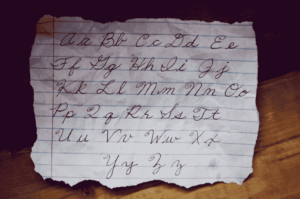Welcome Blessings!
(Tap 🔽 to see more topics!)


Remember last week when we talked about handwriting analysis that might reveal little secrets about your personality? We’re back for round two! This time, we’re looking closer at what your writing supposedly says about you. Did you know that your handwriting is a window into your inner self? We’ll look at things you probably don’t even think about, like how hard you write the letters “m” and “n” or how your writing flows across the page. Get ready to be surprised! You can learn some cool stuff about yourself! (Or at least have some fun thinking about it!)
(Creativity or Practicality?)
Didn’t you know that the shapes of the letters and how you write them, whether rounded or angular, can give you insights? According to graphology, loopy, rounded handwriting indicates that a person is artistic and has an emotionally expressive personality. These people are creative with a vast imagination, have a good taste for beauty, and are emotional.

Angular, sharp handwriting (with fewer loops) suggests a more practical, logical, and analytical mindset. These individuals are often clear thinkers, detail-oriented, and may approach problems from a systematic or structured point of view.
(Your Inner Strength and Willpower)
How you form the letters “m” and “n” can indicate your approach to challenges and how you handle them. If these letters have sharp, pointed peaks, they signify mental strength, decisiveness, and high energy. People who write their “m” and “n” this way tend to face problems head-on and are determined to overcome obstacles.

Flat-topped “m”s and “n”s may suggest a more practical, cautious approach. These individuals tend to take their time making decisions and prefer to think things through rather than rush into action.
(Flexibility vs. Stubbornness)
The way you curve the letter “e” can reveal how flexible or set in your ways you are. A rounded “e” indicates flexibility and adaptability. These individuals are open to new experiences, willing to go with the flow, and quickly adapt to changing circumstances.

However, sharp, angular “e” s may indicate a more rigid, determined personality. People who write “e” this way may resist change and prefer things to stay predictable and organized.
(Open vs. Closed Personality)
Forming the letter “o” can give clues about your openness and communication style. A large loop in your “o” suggests you’re open, trusting, and emotionally accessible. You’re likely the type to share your thoughts and feelings openly, making it easier for others to connect with you.

A smaller, more closed “o” could indicate someone more reserved or guarded. These individuals may spend time opening up to others and be more private or introspective. This trait often reflects a person who prefers to keep certain aspects of their life to themselves.
(How You Handle Conflict)
Writing “x” could reveal how you approach conflict and confrontation. If you tend to make sharp, straight lines when forming your “x,” this could indicate that you’re a direct and decisive person, especially when resolving issues. You likely confront problems head-on and don’t shy away from difficult conversations.
On the other hand, a soft, rounded “x” might indicate a more passive, conflict-averse personality. Avoid confrontation and look for peaceful, harmonious solutions. Your “x” might show that you maintain balance and avoid arguments when possible.
(Sensitivity and Emotional Intensity)
How you write the letter “s” can give insight into your emotional depth and sensitivity. A smooth, rounded “s” suggests someone who is nurturing and intuitive. People with this type of “s” often have a strong connection to their feelings and with the emotions of those around them. They are usually empathetic and compassionate, making them great listeners and supportive friends.
In contrast, a sharp, angular “s” might indicate a more controlled, logical, emotional approach. These individuals keep their feelings in check and prefer rationality over emotional expression. They may not openly express their inner world but instead, choose to process emotions internally.
(Predictability vs. Creativity)
The consistency in your handwriting, from the shape of your letters to their size and spacing, can tell a lot about your need for order versus spontaneity. People with highly consistent handwriting are methodical, disciplined, and reliable. They value structure and are dependable in both their work and personal lives. They tend to be people who plan and stick to their routines.
If you see handwriting with fluctuating letter sizes, erratic slants, and irregular spacing, these often indicate adaptability and creativity. People with this type of handwriting also like exploring new ideas and are open to change. They think outside the box and don’t worry about uncertainties.
(Your Approach to Intellect)
Another interesting thing in graphology is how we write “g,” which reflects how we approach intellectual matters. A well-formed “g” with a distinct loop suggests a person values thoughtfulness and intelligence. These people may prefer intellectual pursuits and high analytical skills. Graphologists say that people in this group enjoy exploring complex subjects and have sharp minds.
A poorly formed “g,” or one that lacks an explicit loop, might suggest someone more intuitive or prefers practical, hands-on learning over abstract theory. People with this writing style value experience over analysis and think in more practical terms.
(Your Energy Levels)
Do you know that through handwriting, you can also see the energy level or the kind of enthusiasm a person has? It says that people with heavy writing, where you can see that the ink is pressed so deeply into the paper, indicate a person with passion, intensity, and energy. So, people in this category might be enthusiastic, determined, and have a personality that demands attention.
Light handwriting, on the other hand, can indicate a more reserved, gentle personality. These individuals might have a calmer, quieter presence and might not always be the first to speak up, but they are sensitive and thoughtful. They often have a laid-back energy and avoid drawing too much attention to themselves.
(Leadership vs. Submissiveness)
Are you submissive or have the potential to be a leader? Let us look into how you write that “L. “Yes, the letter “L.” If you write the letter “L,” tall and straight, it signals assertiveness and confidence. You belong to a group with strong leadership skills and a desire to guide others. You will typically see this kind of person standing tall and showing a commanding presence.
A shorter, sloped “l” might suggest a more passive or submissive personality. People with this “l” type tend to be more agreeable, preferring to follow rather than lead. They are likelier to follow the flow than take charge of a situation.
(Openness to Relationships)
Would you like to know if you are open to relationships or not? Then, look at the size and shape of the loops in your letters “p” and “b.” It suggests that people who write the letters in large, full loops indicate that they are affectionate and willing to form meaningful yet deep relationships. These people are said to be approachable and warm.
Tighter, more restrained loops in these letters may indicate someone more cautious or reserved about forming relationships. They might take time to trust others and prefer to keep a certain emotional distance until they feel comfortable.
(Flexibility vs. Rigidity in Thought)
Next, let us check how flexible and rigid you are. Shall we? If you have an open “c,” you don’t worry about change and are highly adaptable and open-minded. You don’t have problems trying different approaches to life’s unpredictability.
However, a narrow, closed “c” suggests a more rigid, fixed way of thinking. These groups may have strong opinions and resist change or anything that challenges their worldview. They may prefer familiar, established routines and ideas over anything new or untested.
(Resolution vs. Ambivalence)
How you end your sentences can provide insight into how you resolve issues in life. Suppose your writing ends with a firm, decisive stroke (whether a challenging period or a clear, sharp final letter). In that case, this can indicate someone who is resolute, decisive, and confident in their actions. These individuals like closure and resolution and approach challenges with a sense of finality.
Suppose your handwriting trails off with no clear ending (like an open, unfinished stroke or an incomplete letter). In that case, it suggests someone who struggles with decision-making, leaves things unresolved or feels uncertain. These individuals find it difficult to commit to final choices or have an ambivalent approach to life’s challenges.

Today, we have explored the fun world of handwriting analysis, exploring hidden secrets in our loops and slants. Whether your “t” cross shows you are super ambitious or you think otherwise, we hope you had a fun time! Remember, handwriting analysis (graphology) is more like an interesting parlor game than science. There is no actual scientific evidence that your handwriting reflects your personality in any meaningful way. Psychologists generally consider it a pseudoscience.
However, we are exploring it because many people, including me, find it fascinating! It also raises interesting questions about how we try to understand ourselves and others. With that said, now, write whatever you want! The possibilities are endless in a poem, a novel, a grocery list (but don’t make any big decisions based on how you dot your “i”)! Just have fun with it! Thanks for reading. Voila! Until next time!
Additional References:
British Graphology Institute. (n.d.). The history of graphology. Retrieved from https://www.britishgraphology.org/the-history-of-graphology/
wikiHow. (n.d.). Analyze handwriting (graphology). Retrieved from https://www.wikihow.com/Analyze-Handwriting-(Graphology
Joe Schwarcz. (n.d.). Will graphology become extinct?. McGill Office for Science and Society. Retrieved from https://www.mcgill.ca/oss/article/critical-thinking-pseudoscience-history/will-graphology-become-extinct
BusinessBalls.com. (n.d.).
Graphology – handwriting analysis. Retrieved from https://www.businessballs.com/self-awareness/graphology-handwriting-analysis/